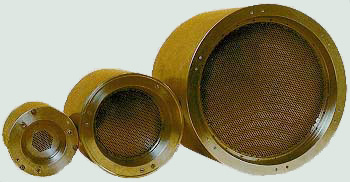
Gridded ion sources provide obtaining broad monoenergy beams of ions of both inert and active gases. Ion beam current - from 0.2 mA up to 1 A, ion energy - from 50 eV up to 1.5 (5) keV.
Characteristics of ion sources depend on characteristics of their constituent parts. A choice of ion source's components should be carried out according to features of a concrete application. Platar Co., Ltd. offers various types of gridded ion sources for nanotechnologies.






Principle of operation of gridded ion sources is in generating ions in discharge plasma, extracting ions, their electrostatic acceleration and a forming an ion beam with a subsequent neutralization of beam’s space charge with electrons. Ion sources are classified in accordance with applied discharge’s type (or cathode type) and with an output shape of ion beam.
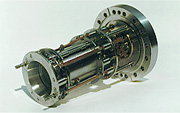
Kaufman type ion sources with filament are the most well-known. They operate on inert gases (Ar, Kr, etc.). A lifetime of filament cathodes is sufficient in most applications. Cathodes are made of a tungsten wire. A replacement of cathodes is not difficult and doesn't require much time.
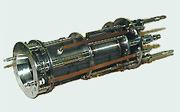
Ion sources with cold hollow cathodes
have a possibility of operation on inert and active gases (N2, O2 mixtures and other) with a long lifetime due to a structure of cathodes based on glow discharge. Besides, as far as a cold hollow cathode is positioned out of a discharge chamber and is cooled, a heat evolution in a discharge chamber is minimum that is important at low-temperature processing.
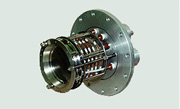
Radiofrequency (RF) ion sources based on an induction RF
discharge (13.56 MHz) can reliably work at using a larger range of active gases (O2,
C2H8, etc.). Application of this type of the discharge in ion sources contributes to an increase of an ion beam purity which is a dominant factor for some applications.
Round ion sources create axis-symmetrical beams with outlet diameters from 2 mm to 20 cm and also elliptical ion beams. The sources are being used for a processing, as a rule, round substrates (targets) which are placed perpendicularly or are tilted about a beam axis.
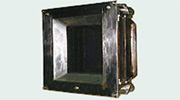
Rectangular ion sources are intended, as a rule, for a creation of beams outstretched in one direction and have a maximum beam’s outlet size up to 80 cm. They are being used, in particular, for a treatment of length substrates (films, bands).
Basic components of gridded ion sources are: a discharge chamber, in which an ionization of operating gas takes place, an ion optics accelerating ions and forming an ion beam and a cathode- neutralizer which is a source of electrons for a compensation of an ion beam space charge. Besides, ion sources based on direct current include a discharge-chamber cathode providing keeping a discharge in a chamber.
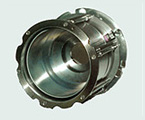
Discharge chambers of direct current' ion sources (with filaments and with cold cathodes) includes a frame, an anode and a magnetic system. In ion sources with outlet beam diameter equal and less than 10 cm systems with divergent magnetic field are applied. Sources with a diameter more than 10 cm contain multi-pole magnetic systems. Main parts of discharge chambers are made of stainless steel or other materials suitable for concrete processes.
Discharge chambers of RF ion sources include a quartz frame and a cooled inductor.
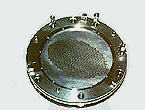 Two-grid ion optics consists of two perforated grids. These accelerating systems are simple in design, inexpensive and are being used very widely, especially, at a creation of ion beams with energy more than 200-300 eV.
Two-grid ion optics consists of two perforated grids. These accelerating systems are simple in design, inexpensive and are being used very widely, especially, at a creation of ion beams with energy more than 200-300 eV.
Three-grid ion optics consists of three perforated grids. These systems provide a smaller divergence of ion beams with energy up to about 500 eV than two-grid systems. Besides, three-grid optics allows decreasing a beam contamination connected with sputtering of an accelerating grid by charge-exchange ions.
Defocused ion optics includes convex grids. It is applied, as a rule, at a processing of large
substrates whose sizes exceed outlet beam sizes. Grids with the special profiled shape are developed for Platar ion sources.
Due to such grids a significant increase of uniform beam zone is achieved. The material of grids is titanium.
Focused ion optics includes concave grids. Provides an obtaining ion beams with high
current density on a target (a substrate). The material of grids is titanium.
Flat ion optics is being applied very often because it satisfies to requirements of many
applications. The materials of grids is molybdenum.
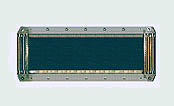
String ion optics is formed by two series of stretched metal strings.
Such ion optics allows to avoid problems connected with thermal instability of grids and is perspective for large ion sources
(especially, length ones).
Filament cathodes-neutralizers include one or two filaments. Immersed cathodes are placed
into an ion beam and provide a good beam neutralization. External cathodes are placed outside (near) an ion beam. In this case
a beam contamination (connected with filament sputtering) is decreased.

Plasma bridge cathodes-neutralizers consist of a small chamber with a
hot filament inside. Like immersed cathodes they provide the good beam neutralization but don't contaminate an ion beam
practically. This type of a neutralizator needs a separate gas feed system.
Cold hollow cathodes-neutralizers have same design like discharge chamber’ cold hollow cathodes and provide big lifetime. They also need an additional gas feed system.


